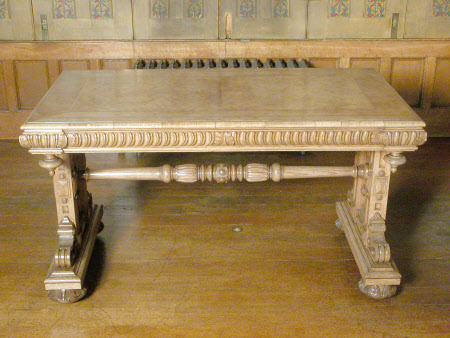Table
after Thomas Willement (London c.1786 - Faversham 1871)
Category
Furniture
Date
circa 1835
Materials
Carved oak and burr walnut veneer
Measurements
76.2 x 139.7 cm; 77.5 cm (Width)
Order this imageCollection
Charlecote Park, Warwickshire
NT 532975
Summary
An oak table, circa 1835, the rectangular top veneered with burr-walnut, above a frieze of ogees issuing inverted finials to each angle, on two trestle end supports joined by a tapering and turned high stretcher . This table is comparable to a pair with a Roman marble top and a different frieze (NT 532972.1-2). These tables are thought to have been designed by Willement for Charlecote circa 1835 and made in London. According to C.Wainwright "they were the most innovatory pieces of furniture designed for the house". They can be paralleled with tables from Aston Hall created by Richard Bridgens and published in his book 'Furniture with Candelabra' (1825).
Provenance
Presented to the National Trust by Sir Montgomerie Fairfax-Lucy (1896 – 1965), two years after the death of his father, Sir Henry Ramsay-Fairfax, 3rd Bt (1870 – 1944), with Charlecote Park and its chief contents, in 1946.
Makers and roles
after Thomas Willement (London c.1786 - Faversham 1871), designer
References
Wainwright, 1989: Clive Wainwright, The romantic interior: the British collector at home, 1750-1850. Studies in British Art. New Haven; London: Paul Mellon Centre for Studies in British Art by Yale University Press, 1989. [Charlecote pp.208-240]
